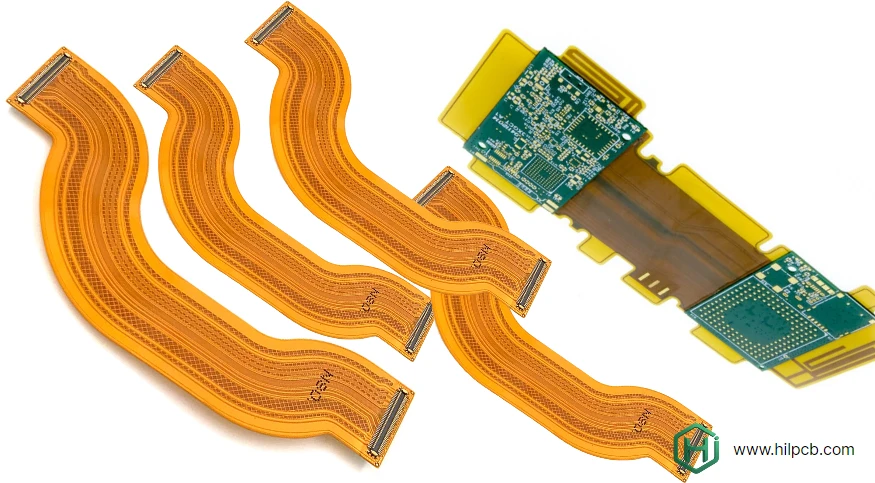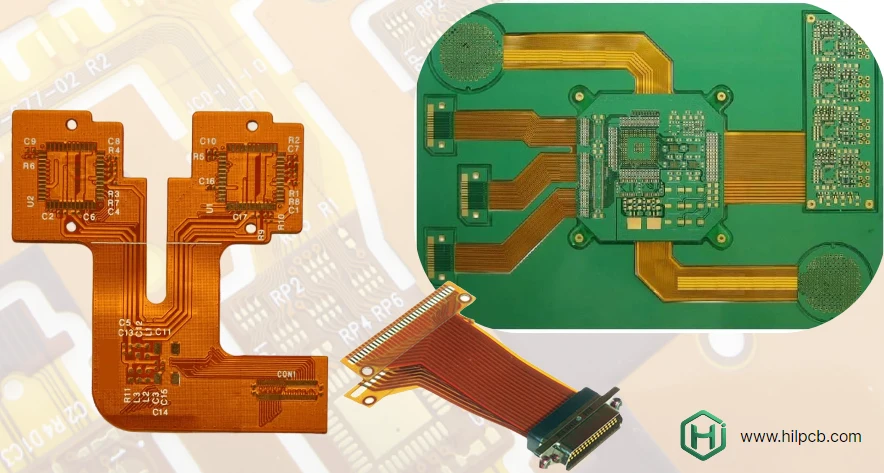At HILPCB, we design and manufacture every type of printed circuit board — from ultra-flexible rollable circuits and rigid-flex PCBs to high-power ceramic and glass PCBs. Our vertically integrated facility in China supports complete PCB solutions including design engineering, lamination, surface finishing, and turnkey assembly.
With over a decade of experience in high-reliability PCB fabrication, we supply global customers across consumer electronics, medical, aerospace, and automotive industries. Our latest innovation — rollable PCB technology — enables new-generation products like rollable smartphones, OLED TVs, and deployable solar devices where circuits must endure tens of thousands of rolling cycles without performance loss.
Rollable PCB Engineering Fundamentals
Rollable PCB represents the most demanding category of flex PCB technology, requiring circuits to maintain electrical integrity through continuous rolling and unrolling cycles. Unlike bendable PCB designs that may bend only during installation, rollable applications subject circuits to dynamic stress patterns requiring specialized engineering approaches.
Critical Design Parameters for Rolling Applications
Material Stack-Up Optimization:
- Ultra-thin polyimide substrates (12.5μm to 25μm) minimizing total thickness
- Rolled annealed copper exclusively (electrodeposited copper fails under rolling stress)
- Adhesiveless constructions eliminating potential delamination points
- Symmetric layer arrangements positioning copper around neutral axis
Roll Diameter Requirements: Minimum roll diameter directly impacts circuit reliability. Typical specifications include:
- Consumer electronics: 10-15mm roll diameter
- Professional displays: 15-25mm roll diameter
- Industrial applications: 20-40mm roll diameter with enhanced durability
Neutral Axis Engineering: For multilayer PCB rollable constructions, positioning copper layers symmetrically around the substrate neutral axis minimizes mechanical strain during rolling. Asymmetric designs create uneven stress distribution accelerating failure.

Advanced Manufacturing Technologies for Rollable Circuits
Specialized Material Processing
HILPCB's rollable PCB manufacturing incorporates technologies unavailable at standard flex manufacturers:
Adhesiveless Lamination Systems: Our investment in adhesiveless flex lamination equipment produces circuits 20-30% thinner than adhesive-based alternatives. This thickness reduction directly improves rolling capability while eliminating adhesive degradation as a failure mechanism.
Rolled Annealed Copper Processing: Standard electrodeposited copper exhibits crystalline structures that fatigue under repeated rolling. We specify rolled annealed copper with carefully controlled grain structure providing 10x superior flex life for rolling applications. Post-processing annealing further relieves internal stresses.
Ultra-Precision Photolithography: Rollable circuits require extremely fine features—often 50μm traces and spaces—maintaining tight tolerances across ultra-thin substrates. Our advanced photolithography equipment includes:
- Laser direct imaging (LDI) systems for ±10μm registration accuracy
- Automated optical inspection verifying feature dimensions
- Climate-controlled processing maintaining dimensional stability
Specialized Coverlay Application: Coverlay adhesion becomes critical for rolling applications where delamination exposes circuits to damage. We employ:
- Vacuum lamination preventing air entrapment
- High-bond acrylic adhesives tested for rolling endurance
- Selective coverlay designs minimizing stiffness while maximizing protection
Assembly Considerations for Rollable Products
SMT assembly for rollable PCBs requires specialized approaches:
- Component Exclusion Zones: All active and passive components must locate in static (non-rolling) regions only
- Transition Zone Engineering: Gradual stiffness changes between rigid component areas and rolling sections prevent stress concentration
- Stiffener Integration: Strategic reinforcement supports components and connectors without compromising rolling performance
- Micro-Component Selection: When possible, smaller components (01005, 008004) reduce mechanical loading
Our turnkey assembly services include fixturing designs that support ultra-thin rollable substrates throughout assembly processes without inducing mechanical damage.
Rollable Display Integration and System Design
OLED and Micro-LED Display Applications
Rollable PCBs serve as the backbone for next-generation display technologies:
Rollable Smartphone Displays: Circuits must integrate seamlessly with rollable OLED panels, providing:
- High-speed data transmission (MIPI DSI at 4+ Gbps)
- Touch controller interfaces with 120Hz+ refresh rates
- Backlight driver circuits (for LCD variants)
- Ambient light and proximity sensor integration
Rollable Television and Monitor Panels: Large-format rollable displays require sophisticated PCB designs:
- Multiple rollable PCB sections coordinating as system
- High-speed PCB routing for 4K/8K video signals
- Power distribution managing 50W+ display consumption
- Thermal management for driver ICs and power circuits
Automotive Rollable HMI: Emerging automotive applications demand rollable circuits meeting:
- AEC-Q200 reliability standards
- -40°C to +105°C operating temperature range
- Vibration and shock resistance per automotive specifications
- 15+ year operational life with 10,000+ rolling cycles

Dynamic Testing and Reliability Validation
Accelerated Life Testing Protocols
HILPCB's reliability testing for rollable PCB exceeds standard flex circuit requirements:
Rolling Endurance Testing:
- Custom test equipment cycling circuits at specified roll diameters
- Continuous electrical monitoring detecting intermittent failures
- Temperature-controlled chambers testing across operating range
- Minimum 50,000 cycle qualification (production targets often 100,000+)
Combined Environment Stress: Real-world rollable products experience multiple simultaneous stresses:
- Temperature cycling during rolling motion
- Humidity exposure combined with mechanical flex
- Vibration and shock loading in portable devices
- Long-term creep and stress relaxation assessment
Electrical Performance Monitoring:
- High-speed signal integrity verification through roll cycles
- Contact resistance measurement at connectors and vias
- Insulation resistance testing detecting early delamination
- Capacitance and inductance changes indicating degradation
Quality Certifications and Standards
Our rollable PCB manufacturing maintains certifications ensuring consistent quality:
- ISO 9001:2015 quality management systems
- IPC-A-610 Class 3 workmanship standards
- IPC-6013 flexible printed circuit specifications
- Industry-specific certifications for automotive and medical applications
Cost Optimization and Manufacturing Scale
Prototype to Production Transition
Low-Volume Prototyping: Initial development batches utilize:
- Laser cutting for tooling-less production
- Standard material specifications reducing lead times
- Rapid iteration supporting design optimization
- Small batch assembly for functional testing
High-Volume Production: Once designs mature, production optimization includes:
- Custom steel rule dies for efficient cutting
- Panel optimization maximizing circuits per production panel
- Automated testing reducing labor costs
- Large volume assembly with dedicated manufacturing lines
Material Selection and Cost Trade-offs
Adhesiveless vs. Adhesive Construction: Adhesiveless systems provide superior reliability and thinner profiles but cost 20-40% more than adhesive-based materials. Application requirements determine optimal choice:
- High-reliability applications justify adhesiveless construction
- Consumer products may utilize adhesive-based materials with proper design validation
- Hybrid approaches use adhesiveless in critical rolling zones only
Copper Weight Optimization: Thinner copper (0.5oz or ½oz) enhances rolling capability but may limit current capacity:
- Signal circuits typically use ½oz copper
- Power distribution may require 1oz copper with relaxed rolling requirements
- Strategic copper thickness variation optimizes performance vs. flexibility
Frequently Asked Questions — Rollable PCB
Q1: What is the difference between rollable PCB and standard flexible PCB?
A: Rollable PCB is specifically engineered for continuous rolling/unrolling motion with specialized materials (rolled annealed copper, ultra-thin substrates) and designs optimized for rolling stress. Standard flex PCB may flex during installation but doesn't require continuous rolling endurance.
Q2: What is the minimum roll diameter achievable for rollable PCBs?
A: Minimum roll diameter depends on total circuit thickness and layer count. Single-layer rollable circuits achieve 8-10mm diameter; multilayer constructions typically require 15-25mm minimum. Tighter diameters are possible with ultra-thin materials but require extensive testing validation.
Q3: How many rolling cycles can rollable PCBs withstand?
A: Well-designed rollable PCBs achieve 50,000 to 100,000+ rolling cycles. Consumer applications typically target 20,000-50,000 cycles; professional equipment may require 100,000+. Actual cycle life depends on roll diameter, material selection, and environmental conditions.
Q4: Can components be placed on rollable PCB sections?
A: No. All components, connectors, and rigid features must locate in static (non-rolling) zones. The rolling section must remain free of any rigid elements. Rigid-flex PCB constructions combine rigid component areas with rollable interconnects.
Q5: What certifications does HILPCB maintain for rollable PCB manufacturing?
A: We maintain ISO 9001:2015, IPC-A-610 Class 3, and IPC-6013 certifications. For industry-specific applications, we support automotive (IATF 16949), medical (ISO 13485), and aerospace (AS9100) quality requirements. Our testing laboratories perform comprehensive reliability validation including rolling endurance testing.

